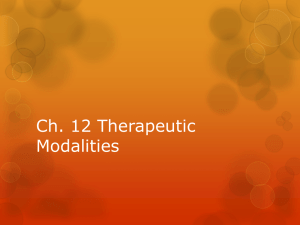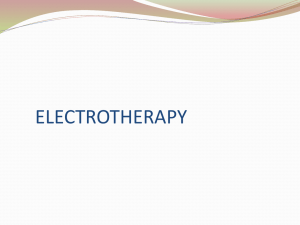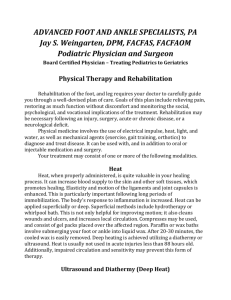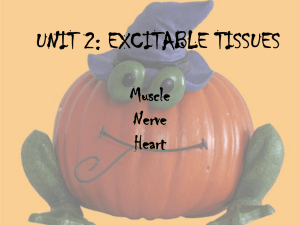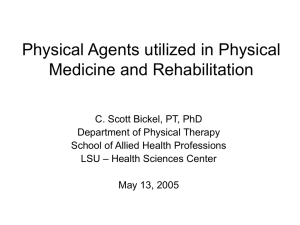SM Chapter 12 Notes
advertisement
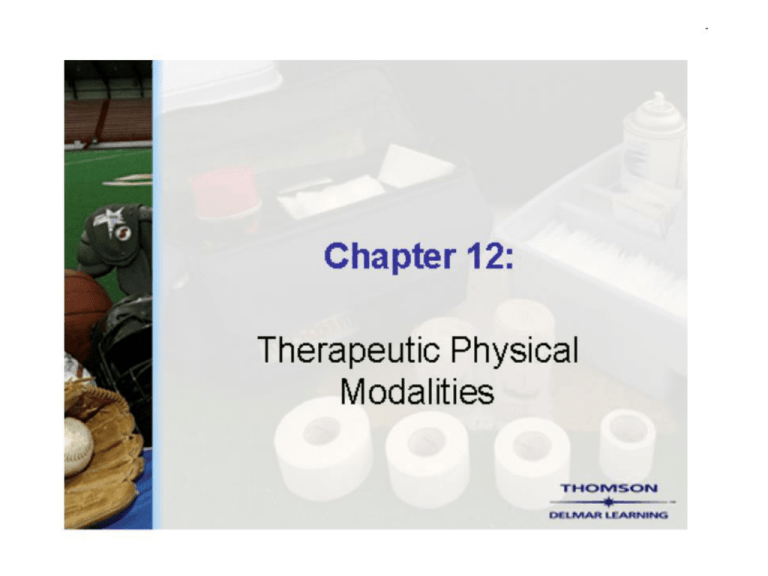
Cryotherapy • Cold packs, cold bucket baths, and ice massage are all used in the management of pain and edema. They are also effective in decreasing muscle guarding and spasm. • Body reaction to cryotherapy include initial vasoconstriction, reduction of tissue metabolism, decreased nerve conduction velocity, reduction of muscle spasm, secondary vasodilatation, and an increase in muscle strength after treatment. Cryotherapy • Cold is the modality of choice for acute injuries, and should be applied as soon as possible, for a maximum of 20 minutes at a time (with 2 hours before reapplication), three to four times per day. • Ice massage, often used for tennis elbow and shin-splints, involves briskly rubbing ice over the injured area to produce the desired cold effect; the advantage is a short treatment of about 5 minutes. Cryotherapy • Cold-water compression, using a commercial sleeve that filled with ice water and available in different shapes for different body parts, combines the effects of cold with the effects of compression. Therapy time is 15 to 20 minutes. • Cryotherapy should be used with caution on persons who have thermoregulatory problems, sensory deficits, hypersensitivity to cold, impaired circulation, heart disease, and malignant tissue. Heating agents • Beneficial effects of heat therapy include reducing pain, promotion of healing, increased range of motion, and muscle relaxation. • Body responses include substantially increased vasodilatation, increased matabolism, capillary pressure and flow, clearance of metabolites, and oxygenation of tissue. Heating agents • Since the body naturally responds with changes similar to the application of heat, heat therapy is usually only appropriate when the natural responses have subsided. • Heat is not typically used until 48-72 hours after the injury. • Heat should not be used with athletes who have impaired circulation, in areas of diminished sensation, when athletes are heat intolerant, or in areas susceptible to bleeding. Hydrotherapy • Is a form of superficial heating that uses agitated, heated water in a whirlpool, which is typically made of stainless steel or fiberglass and attached to a turbine that mixes air with water under pressure to produce turbulance. – Larger areas can be treated and range-of-motion exercises can be performed. – Disadvantages include the great amount of time needed for filling and cleaning, space for the whirlpool, equipment expense, and the inability to elevate the body part being treated. – Treatment time is 10 to 20 minutes. Contrast Therapy • Contrast Therapy uses alternating hot and cold water baths for the ankle, foot, hand, or elbow. – It may be used in the subacute stage of an injury, or 48 to 72 hours after injury to help reduce swelling and pain and increase range of motion. – Contraindications include impaired circulation as a result of diabetes, vascular disease, and a tendency to hemorrhage. Ultrasound • Ultrasound (ultrasonic diathermy) is a very highfrequency sound wave that is absorbed by tissues high in protein content, including tendons, ligaments, joint capsules, and muscle tissue. The sound waves are transformed into deep heat within the targeted tissue. – Certified athletic trainers’ use of electrical therapeutic modalities is limited by some states practice acts, some states permitting only preparation of the patient, while other states allow a more active role in clinical settings. – Ultrasound should not be used over fluid-filled cavities, eyes, heart, uterus, testes, bone growth plates, fracture sites, artificial joints, and herniated discs. It is also not recommended during the acute stage of an injury. – Treatment is usually 5 to 10 minutes. Therapeutic Electrical Modalities • Physicians, physical therapists, and Certified athletic trainers are the primary user of therapeutic electrical modalities. • These modalities achieve their effect by stimulating nerve tissue without heat or cold. Electrical Stimulation (E-Stim) Therapy • E-Stim has proven effective in increasing range of motion and muscle strength, reeducation muscle, improveing muscle tone, enhancing function, controlling pain, accelerating wound healing, and reducing muscle spasm. • Neuromuscular electrical stimulation (NMES) is the most common type of E-Stim, which stimulates a peripheral nerve to cause either a sensory or a motor response. • Functional electirical stimulation (FES) is the use of E-Stim to improve function. Electrical Stimulation (E-Stim) Therapy • Transcutaneous electrical nerve stimulation (TENS) is commonly applied with a portable unit for pain control. • Specialized training is a prerequisite for using electrical modalities. • E-Stim should not be used over the carotid sinus, during pregnancy, in individuals with pacemakers, on people who are sensitive to electricity, or any time active motion is contraindicated.
